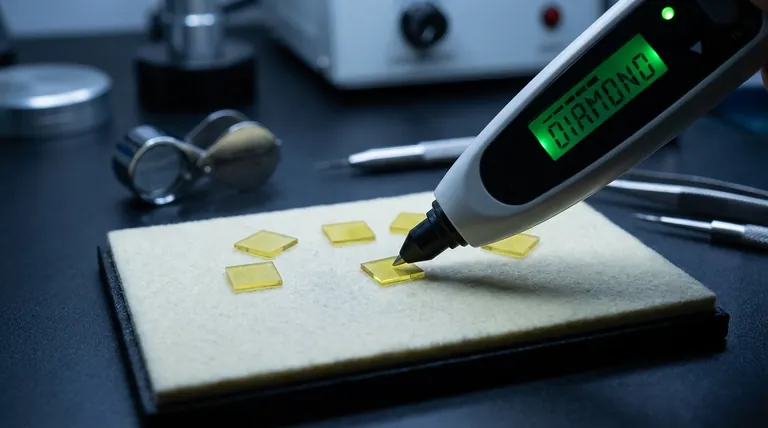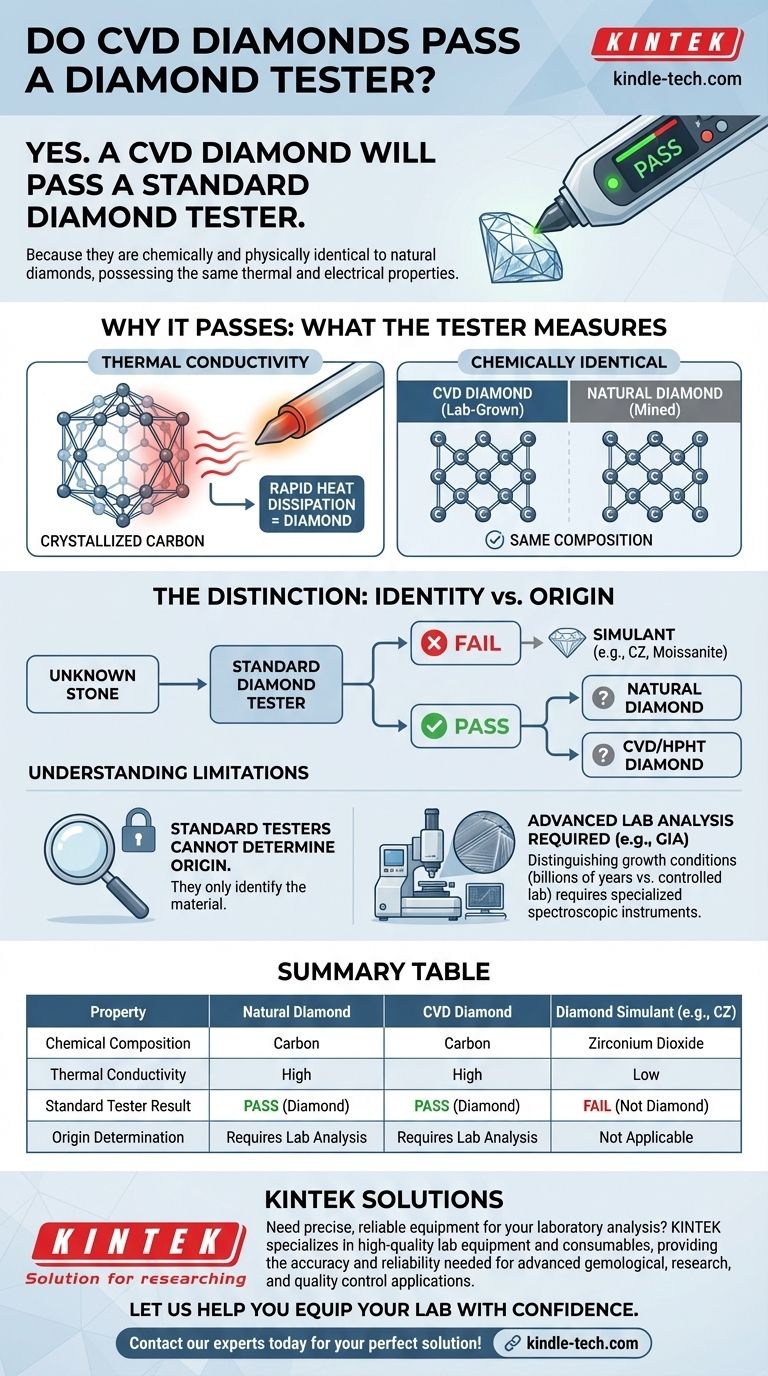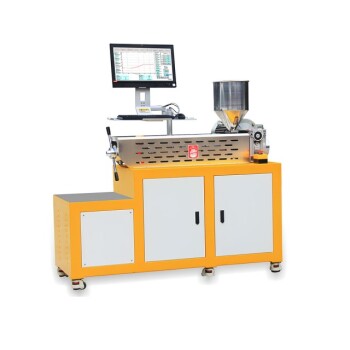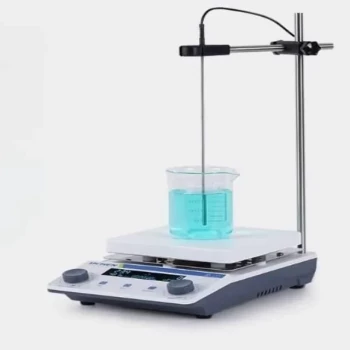Yes, a CVD diamond will pass a standard diamond tester. Because these lab-grown diamonds are chemically and physically identical to natural diamonds, they possess the same thermal and electrical properties that these testers are designed to detect. A handheld tester's purpose is to differentiate genuine diamonds from common simulants like cubic zirconia, not to determine a diamond's origin.
The core reason a CVD diamond passes a standard diamond tester is simple: it is a real diamond. These devices test for the physical properties of diamond, not for its origin. Distinguishing a lab-grown diamond from a natural one requires specialized gemological laboratory equipment.

What a Diamond Tester Actually Measures
Standard diamond testers used by jewelers are not sophisticated origin-detecting machines. Their function is to identify a material based on its unique physical properties.
Thermal Conductivity
The most common type of diamond tester uses a heated probe to measure how quickly heat moves through the gemstone. Diamonds are exceptional thermal conductors, meaning they dissipate heat very rapidly. This property is what the tester primarily looks for.
The Critical Point
CVD (Chemical Vapor Deposition) diamonds are not fakes or imitations; they are crystallized carbon with the exact same atomic structure as mined diamonds. Because their physical composition is identical, their thermal conductivity is also identical. The tester correctly identifies the material as "diamond."
The Difference Between Identification and Origin
This is the central point of confusion for many. A tester confirms a stone's identity, but it cannot reveal its history.
A Chemically Identical Substance
As confirmed by the Federal Trade Commission (FTC), lab-grown diamonds are real diamonds. They share the same chemical makeup, crystal lattice structure, hardness, and optical brilliance as their natural counterparts. To the naked eye, and even a jeweler's loupe, they are indistinguishable.
Where They Differ
The distinction between a natural and a CVD diamond lies in its atomic-level growth structure and the presence of trace elements. Natural diamonds were formed deep within the Earth over billions of years, while CVD diamonds are grown in a highly controlled laboratory environment. These different growth conditions leave subtle markers that can only be detected with advanced equipment.
Understanding the Limitations
Relying solely on a basic diamond tester has significant limitations if your goal is to determine a diamond's origin.
What the Tester Can't Tell You
A standard handheld tester cannot differentiate between a natural diamond and a lab-grown diamond (both CVD and HPHT). It will simply register a positive result for both.
The Need for Specialized Equipment
Top gemological labs like the GIA (Gemological Institute of America) use sophisticated spectroscopic instruments to analyze a diamond's growth patterns and chemical impurities. This is the only definitive way to determine if a diamond is natural or lab-grown.
Quality is a Separate Issue
Passing a diamond test is not a statement of quality. Both natural and CVD diamonds are graded on the exact same "4Cs" scale: Cut, Color, Clarity, and Carat. A high-quality CVD diamond can easily surpass the quality of a low-grade natural diamond, and vice-versa.
How to Apply This to Your Goal
Understanding this distinction is key to making an informed decision, whether you are buying, selling, or simply identifying a stone.
- If your primary focus is buying an authentic diamond: Rest assured that a CVD diamond is a real diamond that will be recognized as such by standard tools, but always demand a grading report from a reputable lab (like GIA or IGI) that clearly discloses its lab-grown origin.
- If your primary focus is identifying an unknown stone: A standard diamond tester is a useful first step to confirm if it is a diamond or a simulant like cubic zirconia, but it cannot tell you if the diamond was mined or created in a lab.
- If your primary focus is verifying a diamond's origin: You must submit the stone to a professional gemological laboratory for definitive analysis; no handheld device can provide this information.
Ultimately, a CVD diamond's ability to pass a standard test is a direct confirmation of its authentic diamond identity.
Summary Table:
| Property | Natural Diamond | CVD Diamond | Diamond Simulant (e.g., CZ) |
|---|---|---|---|
| Chemical Composition | Carbon | Carbon | Zirconium Dioxide (ZrO₂) |
| Thermal Conductivity | High | High | Low |
| Standard Tester Result | PASS (Diamond) | PASS (Diamond) | FAIL (Not Diamond) |
| Origin Determination | Requires Lab Analysis | Requires Lab Analysis | Not Applicable |
Need precise, reliable equipment for your laboratory analysis?
Understanding the subtle differences between materials requires the right tools. KINTEK specializes in high-quality lab equipment and consumables, providing the accuracy and reliability needed for advanced gemological, research, and quality control applications.
Let us help you equip your lab with confidence.
Contact our experts today to find the perfect solution for your specific needs!
Visual Guide

Related Products
- CVD Diamond for Thermal Management Applications
- Cylindrical Resonator MPCVD Machine System Reactor for Microwave Plasma Chemical Vapor Deposition and Lab Diamond Growth
- Microwave Plasma Chemical Vapor Deposition MPCVD Machine System Reactor for Lab and Diamond Growth
- CVD Diamond Domes for Industrial and Scientific Applications
- CVD Diamond Cutting Tool Blanks for Precision Machining
People Also Ask
- What is the use of CVD diamond? Unlock Superior Performance in Extreme Applications
- What substance is used to make lab-grown diamonds? Pure Carbon, Identical to Natural Diamonds
- What is the future of CVD diamond? Unlocking Next-Gen Electronics & Thermal Management
- What is the difference between CVD and original diamond? Choose the Right Diamond for Your Needs
- What is the main difference between CVD and natural diamond? Origin, Purity, and Value Explained



















